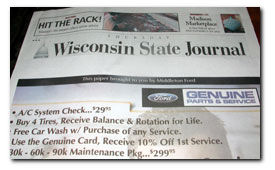
(Click the photo for a larger version)
I walked to the bottom of my driveway early this morning to grab the NY Times (I still get the fishwrap version) and saw that another paper was dropped off (the Milwaukee Journal-Sentinel and the Wisconsin State Journal periodically drop promotional copies around the neighborhood).
The 2nd paper was rather interesting: the first two pages were advertising “Brought to you by Middleton Ford”. Perhaps this advertiser bought x number of copies that were dropped around the area? Most interestingly, the advertiser pages completely covered the Wisconsin State Journal. From the advertiser perspective, it is certainly in your face for those who take the paper out of the bag (why not direct mail?). From the State Journal’s perspective, however, it is a big dilution of the brand. Promo copies (try us) are one thing, but a promo copy completely wrapped in an ad is another.
This approach is identical to traditional advertiser only publications. Perhaps that’s where the daily papers will end up: free to all readers, but with a much larger and more invasive ad presence.
Meanwhile, Joseph T. Hallinan covers McClatchy’s circulation woes at the Minneapolis Star Tribune.
Finally, I took a look at local coverage/links to today’s very unfortunate London events around 7:00a.m. at two popular local news sites, Capital Newspapers’ madison.com site and Morgan Murphy Media’s channel3000.com. At 6:48a.m., channel3000 had a photo of British PM Tony Blair’s press conference along with a story and links. madison.com did not mention this breaking story (they later posted a link to an AP story on the London bombing). (click to view a screen shot of the two sites at 6:48a.m. today). The internet’s news cycle is clearly different than the traditional paper’s 24 hour process.
Having said all that, I think the local sites are much better off 99% focused on local issues. There was and is no shortage of coverage on the London events around the net.

